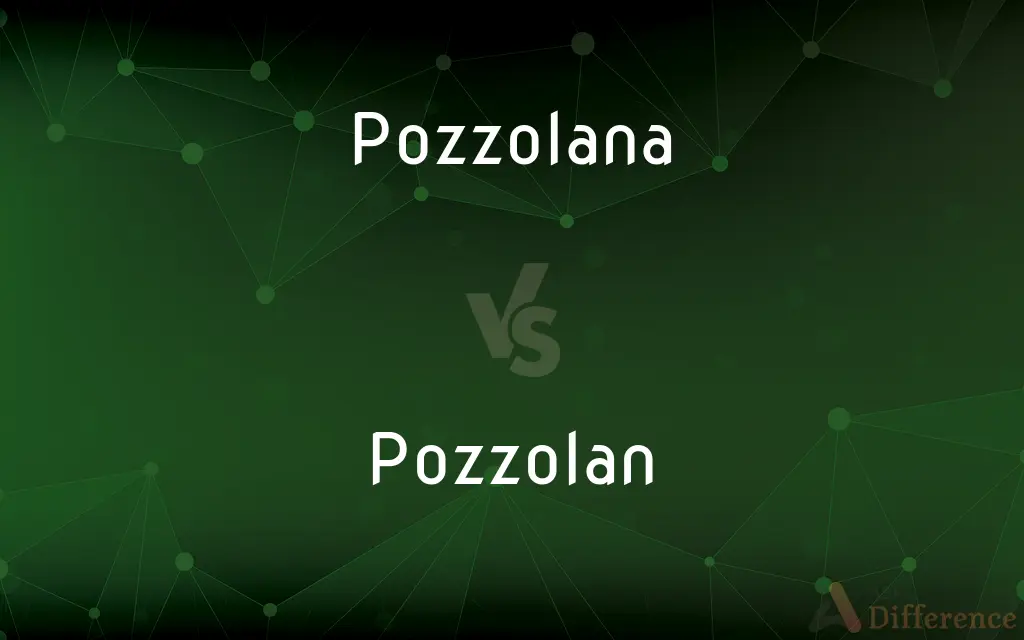Pozzolana vs. Pozzolan — What's the Difference?
Edited by Tayyaba Rehman — By Urooj Arif — Updated on April 17, 2024
Pozzolana refers to volcanic ash used as a cement additive, enhancing hydraulic properties; pozzolan is a broader category of siliceous materials with similar functions.

Difference Between Pozzolana and Pozzolan
Table of Contents
ADVERTISEMENT
Key Differences
Pozzolana specifically denotes volcanic ash found in regions like Pozzuoli, Italy, used historically in cement. Whereas, pozzolan encompasses a wider variety of siliceous and aluminous materials, including both natural and artificial substances, that chemically react with calcium hydroxide at room temperature.
Pozzolana is noted for its role in creating the hydraulic cements of ancient Roman architecture, improving durability and water resistance. On the other hand, pozzolan includes materials like fly ash and silica fume, which are by-products of industrial processes and also enhance modern concrete.
The natural pozzolana, such as those found near Naples, have a rich history in construction, dating back to Roman times. Conversely, artificial pozzolans are a more recent development, tailored to meet specific engineering requirements and often used to reduce the environmental impact of cement production.
Pozzolana typically requires less processing than artificial pozzolans, which may involve complex industrial processes to achieve the desired reactivity and performance characteristics. In contrast, artificial pozzolans can be engineered to provide specific properties, such as increased strength or reduced permeability.
Pozzolana is often mixed with lime to form a binder that exhibits cementitious properties essential for historical construction techniques. Pozzolan materials, however, are integral to modern sustainable building practices, contributing to the reduction of CO2 emissions from the cement industry.
ADVERTISEMENT
Comparison Chart
Origin
Naturally occurring volcanic ash
Both natural and artificial siliceous materials
Use
Historically used in Roman concrete
Used in both historic and modern concrete formulations
Type
Specific type of natural material
Broad category including various natural and artificial materials
Processing
Minimal, often used directly
May require complex processing or activation
Environmental Impact
Low, natural mining
Varied, often lower CO2 footprint when using industrial by-products
Compare with Definitions
Pozzolana
Historically significant building material.
Pozzolana has been used since Roman times for its hydraulic properties.
Pozzolan
A material that reacts with calcium hydroxide.
Fly ash, a type of pozzolan, is added to concrete to improve its strength.
Pozzolana
A natural siliceous material.
Pozzolana reacts with lime to produce a strong binder.
Pozzolan
Used in sustainable building.
Pozzolan is favored in green construction for reducing cement's environmental impact.
Pozzolana
Volcanic ash used in cement-making.
Pozzolana from Pozzuoli was crucial in ancient Roman construction.
Pozzolan
Varied sources and types.
Pozzolans include materials like volcanic ash, fly ash, and rice husk ash.
Pozzolana
Sourced from specific locations.
True pozzolana is sourced from volcanic areas around Italy.
Pozzolan
Enhances concrete properties.
Adding pozzolan to cement mix reduces the permeability of the concrete.
Pozzolana
Used in hydraulic lime mortars.
Pozzolana mixed with lime creates a durable mortar for underwater structures.
Pozzolan
Can be natural or artificial.
Silica fume is an artificial pozzolan used in high-performance concrete.
Pozzolana
Pozzolana or pozzuolana ( POT-s(w)ə-LAH-nə, Italian: [potts(w)oˈlaːna]), also known as pozzolanic ash (Latin: pulvis puteolanus), is a natural siliceous or siliceous-aluminous material which reacts with calcium hydroxide in the presence of water at room temperature (cf. pozzolanic reaction).
Pozzolan
Pozzolans are a broad class of siliceous and aluminous materials which, in themselves, possess little or no cementitious value but which will, in finely divided form and in the presence of water, react chemically with calcium hydroxide (Ca(OH)2) at ordinary temperature to form compounds possessing cementitious properties. The quantification of the capacity of a pozzolan to react with calcium hydroxide and water is given by measuring its pozzolanic activity.
Pozzolana
A siliceous volcanic ash used to produce hydraulic cement.
Pozzolan
A siliceous volcanic ash used to produce hydraulic cement.
Pozzolana
Any of various powdered substances that react with lime to form strengthening or enhancing compounds in cement.
Pozzolan
Any of various powdered substances that react with lime to form strengthening or enhancing compounds in cement.
Pozzolana
A type of volcanic ash used for mortar or for cement which sets under water.
Pozzolan
Any material which, when combined with calcium hydroxide, exhibits cementitious properties; often used as an extender with Portland cements.
Common Curiosities
What is pozzolana?
Pozzolana is a type of volcanic ash used as an additive in cement, enhancing its hydraulic properties.
Where is pozzolana found?
Pozzolana is typically found in volcanic areas, notably around Pozzuoli, Italy.
What are examples of pozzolans?
Examples of pozzolans include fly ash, silica fume, and natural volcanic ash.
Why is pozzolana important in construction?
It contributes to the durability and water resistance of hydraulic cements, particularly noted in ancient Roman constructions.
How do pozzolana and pozzolan react chemically in concrete?
They react with calcium hydroxide to form compounds that improve the strength and durability of concrete.
How does pozzolan differ from pozzolana?
While pozzolana specifically refers to volcanic ash, pozzolan includes a broader range of siliceous materials that serve similar purposes in cement.
What is the environmental impact of using pozzolana and pozzolan?
Both materials help reduce the environmental impact of cement production, with pozzolans often used to utilize industrial by-products.
What role does pozzolana play in sustainable construction?
Pozzolana, especially when sourced naturally, minimizes the environmental footprint of building materials.
Is pozzolana still used today?
Yes, it remains a valuable component in specialty cements, particularly for restoration of historic structures.
How do natural and artificial pozzolans compare?
Natural pozzolans typically require minimal processing, whereas artificial pozzolans can be engineered to meet specific performance criteria.
Can pozzolan be used in all types of concrete?
Pozzolans are versatile and can be used in various concrete mixtures, tailored to specific construction needs.
Can pozzolan be synthetic?
Yes, pozzolans can be synthetic, such as silica fume, which is produced from industrial processes.
What historical structures utilized pozzolana?
Historical Roman structures like the Pantheon and aqueducts utilized pozzolana for its hydraulic properties.
What advancements have been made in pozzolan technology?
Advances include the development of high-performance artificial pozzolans, which improve the reactivity and efficiency of cementitious materials in concrete.
What are the benefits of using pozzolan in modern concrete?
Pozzolan enhances the mechanical properties and sustainability of concrete, making it more suitable for modern engineering demands.
Share Your Discovery

Previous Comparison
Barracks vs. Barrack
Next Comparison
Store vs. SupplyAuthor Spotlight
Written by
Urooj ArifUrooj is a skilled content writer at Ask Difference, known for her exceptional ability to simplify complex topics into engaging and informative content. With a passion for research and a flair for clear, concise writing, she consistently delivers articles that resonate with our diverse audience.
Edited by
Tayyaba RehmanTayyaba Rehman is a distinguished writer, currently serving as a primary contributor to askdifference.com. As a researcher in semantics and etymology, Tayyaba's passion for the complexity of languages and their distinctions has found a perfect home on the platform. Tayyaba delves into the intricacies of language, distinguishing between commonly confused words and phrases, thereby providing clarity for readers worldwide.














































